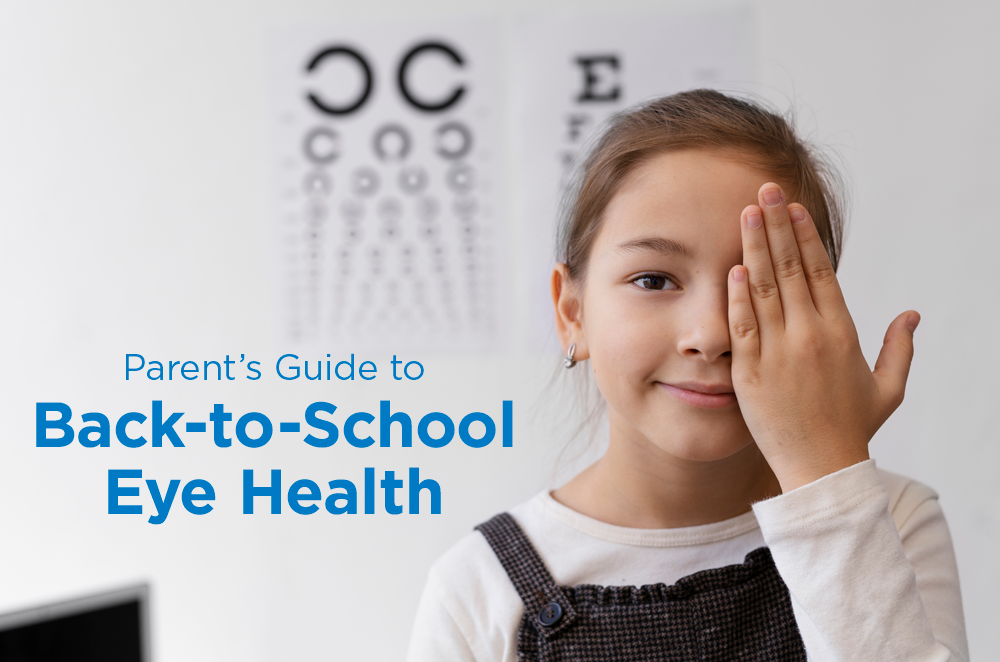The lazy days of summer are winding down, and back-to-school excitement is building. But before you tackle that last-minute supply run, there’s one crucial item you can’t afford to overlook: your child’s eye health. Fortunately, August is Children’s Eye Health & Safety Month, making now the perfect time to book a back-to-school eye exam. Healthy vision is fundamental to a child’s success in the classroom, from reading the whiteboard to tackling homework. To help you make sure your student is ready for a successful school year, we’ve created this Parent’s Guide to Back-to-School Eye Health.
Is a Back-to-School Eye Exam Really Necessary?
Think of an eye exam as a vital part of your child’s back-to-school routine, just like buying new clothes or school supplies. While a vision screening at school or your pediatrician’s office is a good start, it’s important to remember that it doesn’t replace a comprehensive eye exam with an optometrist or ophthalmologist. That’s because a professional eye doctor can check for a wide range of issues, from refractive errors like nearsightedness and farsightedness to more serious conditions that could impact your child’s learning and development. They can also ensure that their eyes are working together correctly to read and focus.
What Should Parents Look For?
As a parent, you know your child best, so you are in the best position to spot potential vision problems. Therefore, it’s a good idea to keep an eye out for these common signs:
- Frequent squinting or rubbing of the eyes
- Holding books or devices very close to their face
- Sitting too close to the television or computer screen
- Complaints of headaches or eye fatigue
- Difficulty concentrating on schoolwork
- Avoiding reading or close-up activities
- One eye turning in or out
If you notice any of these behaviors, then it’s a good idea to schedule an eye exam. Early detection and treatment can make a significant difference in your child’s academic performance and overall well-being.
Protecting Your Child’s Eyes From Injury
Children are naturally curious and active, which sometimes puts their eyes at risk. Whether they’re playing sports, doing science experiments, or just running around the playground, eye injuries are a real concern. To prevent this, here are some simple ways to protect them:
Sports Safety: For example, if your child plays sports with flying objects like baseball, basketball, or hockey, make sure they wear appropriate protective eyewear.
General Play: In addition, for younger children, ensure toys are age appropriate and don’t have sharp edges. Supervise them during activities with potential hazards.
Household Hazards: Keep cleaning supplies, chemicals, and tools stored safely away from children.
Managing Screen Time For Children
It’s no secret that children are spending more time on screens than ever before. Unfortunately, this can lead to a condition known as digital eye strain, with symptoms like dry eyes, headaches, and blurred vision. The good news is, there are simple ways to manage it.
The 20-20-20 Rule: Teach your child to look away from their screen every 20 minutes, at an object 20 feet away, for at least 20 seconds. This simple practice gives their eye muscles a much-needed break.
Proper Lighting and Distance: Make sure their workspace is well-lit and that they are holding their device at a proper distance (about 18-24 inches).
Breaks are Key: Encourage frequent breaks from devices.
Schedule a Back-to-School Exam Today
Back-to-school readiness is about more than just new notebooks and backpacks. Ultimately, it’s about ensuring your child is healthy, happy, and ready to learn. By making eye health a priority, you’re setting them up for success. We encourage you to schedule their back-to-school eye exam today. Your pediatrician can help with vision screening and offer a referral to an eye care specialist if needed. If you need help with scheduling, contact one of our family care physicians. Your child’s future is bright—let’s make sure they can see it clearly.
Resources:
https://preventblindness.org/signs-of-possible-eye-problems-in-children/
https://preventblindness.org/common-childrens-vision-problems-prevalence/
https://preventblindness.org/sports-eye-safety/
Disclaimer:
The Comanche County Memorial Hospital website does not provide specific medical advice for individual cases. Comanche County Memorial Hospital does not endorse any medical or professional services obtained through information provided on this site, articles on the site, or any links on this site.
Use of the information obtained by the Comanche County Memorial Hospital website does not replace medical advice given by a qualified medical provider to meet the medical needs of our readers or others.
While content is frequently updated, medical information changes quickly. Information may be out of date, and/or contain inaccuracies or typographical errors. For questions or concerns, please contact us at contact@ccmhhealth.com.

